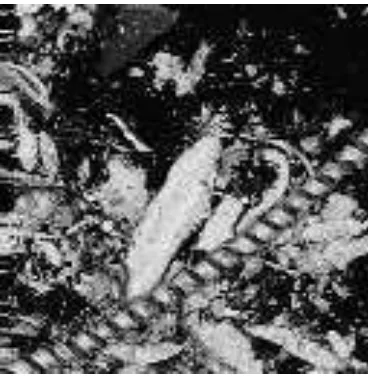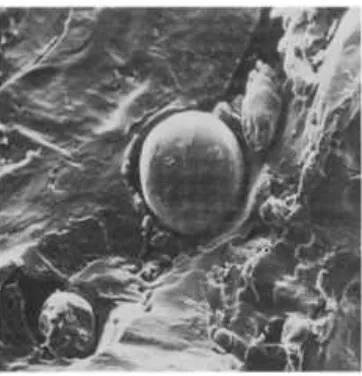WEAR DEBRIS DETECTION AND ANALYSIS OF AUTOMOTIVE ENGINE LUBRICATING OIL
HAFIZUDDIN BIN SHARINGAT
HAFIZUDDIN BIN SHARINGAT B041110021
BMCA
Email: [email protected]
Draft Final Report Projek Sarjana Muda II
Supervisor: PUAN SUSHELLA EDAYU BINTI MAT KAMAL
Faculty of Mechanical Engineering Universiti Teknikal Malaysia Melaka
SUPERVISOR DECLARATION
“I hereby declare that I have read this thesis and in my opinion this thesis is sufficient in terms of scope and quality for the award of the degree of
Bachelor of Mechanical Engineering (Automotive) with Hons”
Signature: ...
HAFIZUDDIN BIN SHARINGAT
This report is submitted in
fulfillment of the requirements for the award of
Bachelor of Mechanical Engineering (Automotive) with Honours
Fakulti Kejuruteraan Mekanikal Universiti Teknikal Malaysia Melaka
DECLARATION
“I hereby declare that the work in this thesis is my own except for summaries and quotations which have been duly acknowledged.”
Signature: ...
Author: HAFIZUDDIN BIN SHARINGAT
DEDICATION
Special to my
ACKNOWLEDGEMENT
Alhamdulillah, all praises to Allah for give me strength and healthy in completing this Projek Sarjana Muda (PSM) with the title of “Wear Debris Detection and Analysis of Automotive Engine Lubricating Oil” until it was completed. All of honours are just for Allah Azza Wajalla, the almighty.
Then, I want to express my sincere thanks to:
My beloved parents, Sharingat and Saimah. Thank you so much for your affection, advices, guidance, instruction and help in all my life, your love is beyond any words. Also all my beloved family for all their support.
My PSM supervisor, Puan Sushella Edayu binti Mat Kamal, I thank you for all the reprimand and guidance as it is very helpful for me in completing this project. Thank you very much for your time to share your great knowledge and great experience to me. I also want to thank to all lecturers for the guidance, assistance and advice about the project as PSM is one of the requirement to graduate.
ABSTRACT
ABSTRAK
Laporan ini mengenai kajian dan pengesanan serpihan besi pada minyak pelincir enjin. Tujuan kajian ini dijalankan adalah untuk mengkaji serpihan besi yang dihasilkan oleh geseran yang berlaku pada bahagian-bahagian dalaman enjin. Serpihan besi terhasil daripada geseran di antara dua bahagian dalam enjin. Serpihan ini akan menyebabkan kerosakan pada enjin jika tidak dikawal dengan baik. Jadi, kajian ini akan membantu jurutera penyelenggara untuk menjadualkan penukargantian dan menyediakan alat ganti bahagian enjin berdasarkan jumlah atau rupa bentuk serpihan besi. Satu ujian geseran telah dijalankan dengan menggunakan mesin pin-on-disc. Daripada ujian geseran tersebut, data yang didapati daripada sistem pengumpulan data diambil untuk dianalisis. Bahan yang digunakan sebagai bahan ujikaji dipilih berdasarkan bahan yang kerap digunakan pada bahagian enjin. Serpihan yang dihasilkan dari geseran antara bahan yang dipilih dengan cakera dari mesin ini telah diambil untuk dianalisis. Scanning
Electron Microscopy (SEM) telah digunakan untuk menganalisis serpihan besi yang
dikumpulkan. Saiz serpihan besi diukur daripada imej yang dihasilkan oleh mesin SEM.
EDX analysis software digunakan untuk mengenalpasti bahan serpihan besi yang
TABLE OF CONTENTS
CHAPTER TITLE PAGE
DECLARATION ii
DEDICATION iii
ACKNOWLEDGEMENT iv
ABSTRACT v
ABSTRAK vi
TABLE OF CONTENTS vii
LIST OF TABLES x
LIST OF FIGURES xi
CHAPTER 1 INTRODUCTION 1
1.0 Background Study 1
1.1 Problem Statement 2
1.2 Objectives 2
1.3 Scope 3
1.4 Content Overview 3
CHAPTER 2 LITERATURE REVIEW 4
CHAPTER TITLE
PAGE
2.1 Fundamental of Wear Debris 5
2.2 Wear Debris Analysis 5
2.3 Wear Debris in Automotive Engine Lubricating Oil
11
2.4 Pin On Disc 13
2.5 Technique in Analyzing Wear Debris 2.5.1 Ferrography
2.5.2 Scanning Electron Microscopy Approach to Wear Debris Analysis
14 14 16
2.6 Coefficient of Friction 17
CHAPTER 3 METHODOLOGY 21
3.0 Introduction 21
3.1 Test Specimen 22
3.1.1 Test Specimen Parameter 3.1.2 Sample Preparation
23 24
3.2 Wear Test 25
3.2.1 Parameter of Wear Test 3.2.2 Wear Test
26 27 3.3 Determining Specific Wear Rate, k and
Coefficient of Friction
28
3.4 Collect Wear Debris 30
3.5 Scanning Electron Microscope (SEM) 31
3.6 Flow Chart 32
CHAPTER 4 RESULTS AND DISCUSSION 34
4.0 Introduction 34
4.3.1 Image of Weear Debris Scanned by SEM 4.3.2 Composition of Wear Debris
4.3.3 The Size of Wear Debris
41 42 52
CHAPTER 5 CONCLUSION AND RECOMMENDATION 57
5.1 Conclusion 57
5.2 Recommendation 58
REFERENCES 59
LIST OF TABLES
NO. TITLE PAGE
2.1 Metals of wear particles in automotive engine 11
3.1 The composition of aluminum alloy 22
3.2 The parameter of the pin-on-disc test 26
4.1 Mass of wear produced and specific wear rate, k 35
4.2 Image of wear debris 41
4.3 Composition of wear debris from first spot 43
4.4 Composition of wear debris from second spot 44
4.5 Composition of wear debris from third spot 45
4.6 EDX analysis for first spot of wear debris 46
4.7 EDX analysis for second spot of wear debris 48
4.8 EDX analysis for third spot of wear debris 50
LIST OF FIGURES
NO. TITLE PAGE
2.1 Rubbing wear particles
(Source: Lovics and Dalley, 2005)
6
2.2 Cutting wear particles
(Source: Lentz and Toms, , http://www.gastopsusa.com 14 December 2014)
7
2.3 Spherical wear particles produced by sliding wear process (Source: Hurricks, 1974)
8
2.4 Severe sliding wear particles (Source: Fitch, 2013)
8
2.5 Case hardened steel gear and bearing wear particles (Source: Lovics and Dalley, 2005)
10
2.6 Low and high alloy steel gear and bearing wear (Source: Lovics and Dalley, 2005)
10
2.7 The schematic diagram of the Ferrographic Oil Analysis System (Source: Lateef et al. 2009)
12
2.9 Ferrogram
(Source: Al-Osaimy et al. 2013)
15
2.10 Example of Scanning Electron Microscope (Source: Hafner, 2007)
16
2.11 Variation of friction coefficient with the variation of duration rubbing and normal load (sliding velocity:1m/s,relative humidity:70%,
pair:aluminum-aluminum)
(Source: Nuruzzaman and Chowdhurry, 2012)
18
2.12 Variation of friction coefficient with the variation of normal load for different material pair (sliding velocity: m/s, relative humidity:70%) (Source: Nuruzzaman and Chowdhurry, 2012)
18
2.13 Variation of friction coefficient with the variation of duration of rubbing and sliding velocity (normal load:7.5 N, relative humidity: 70%, pair: aluminum-aluminum)
(Source: Nuruzzaman and Chowdhurry, 2012)
19
2.14 Variation of friction coefficient with the variation of sliding velocity for different material-pair (normal load:7.5 N, relative humidity:70%) (Source: Nuruzzaman and Chowdhurry, 2012)
19
3.1 Aluminum rod 23
3.2 Schematic diagram of pin-on-disc machine 25
3.3 Wear Test 27
3.4 Wear debris collected by using filter paper 30
3.5 Schematic diagram of Scanning Electron Microscopy (SEM) 31
3.6 Flow chart of the research 32
4.1 Mass loss at different load applied 36
4.2 Specific wear rate at different load applied 37
4.3 Variation of coefficient of friction with variation of time of sliding at different load applied
38
4.4 Variation of coefficient of friction with variation of time of sliding at different load applied
39
magnification 1500x
4.8 Graph of average size of wear debris against load applied at different speed
CHAPTER 1
INTRODUCTION
1.0 BACKGROUND STUDY
1.1 PROBLEM STATEMENT
The condition of engine operation are related to the process of wear debris generation and their morphology. Wear debris generated are harmful to the engine parts if not controlled properly. So, classification of debris in different morphological classes provided valuable information on the current state of tribosystems. Thus, this research of wear debris detection and analysis of automotive engine lubricating oil will helps the maintenance engineer to scheduled the overhauled of the spares and replacement of engine parts.
1.2 OBJECTIVES
1.3 SCOPE
The scope of this research was to conduct tribological testing. Pin-on-disc machine was used in this experiment. Aluminum rods with 12 mm diameter were used as the material for this experiment. The main consideration in this experiment was to collect wear debris produced from the experiment to investigate its correlation between wear rate and coefficient of friction.
1.4 CONTENT OVERVIEW
LITERATURE REVIEW
2.0 INTRODUCTION
2.1 FUNDAMENTAL OF WEAR DEBRIS
According to Alfred (2005), wear appears as gradual removal of a material from contacting and rubbing surfaces of solids during their relative sliding. The mechanism of wear involves formation of debris particles. The particles have small sizes and different shapes. The wear debris can be rolled over into cylindrical, spherical and needle-like particles. Particles are detached from rubbing surfaces and they form a more or less continuous interfacial layer. They transmit forces, momentum and displacement at the contact interface. The presence of wear debris between sliding surfaces affects frictional and wear behaviour significantly.
The friction process elements operating in contact conditions always involves heat generation and wear of their surfaces. Wear and frictional heat apart from fatigue, fracture and corrosion are main factors which restrict a life time of machines and mechanical devices. Numerous machine component parts must be taken out of service not due to failure caused by exceedence of the limit stress but due to wear manifested in removal of a material.
2.2 WEAR DEBRIS ANALYSIS
Particles. The particles are differentiated to each classes to determine their type of wear and its source.
Normal Rubbing Wear happened when two parts/materials under load slide into each other and causes wear of parts of the shear mixed layer. Rubbing wear particles consists of flat platelets, generally 5 microns or smaller, although they may range up to 15 microns depending on equipment application. There should be little or no visible texturing of the surface and the thickness should be one micron or less. In automotive engine parts, this type of wear particles usually occurs in rotating shafts and valve seats. Figure 2.1 shows the sample ofRubbing Wear particles.
Figure 2.1: Rubbing wear particles (Lovics and Dalley, 2005)
particles stand out and penetrate the opposing wear surface. The particles that produces by this way are very fine wire-like particles. The thickness are about 25 microns and 5 microns long. Figure 2.2 shows the image of cutting wear particles.
Figure 2.2: Cutting wear particles (Lentz and Toms, n.d)
Figure 2.3: Spherical wear particles produced by sliding wear process (Hurricks, 1974)
For severe sliding wear particles, this types of particles are identified by its parallel striations on their surfaces. The size are basically more than 15 micron, with length-to-width thickness ratio between 5 and 30 microns. Severe sliding wear particles sometimes show evidence of temper colour which may change the appearance after heat treatment process. Figure 2.4 shows the image of severe sliding particles. The parallel striations on the surface of the particles indicate the sliding motion happened.

